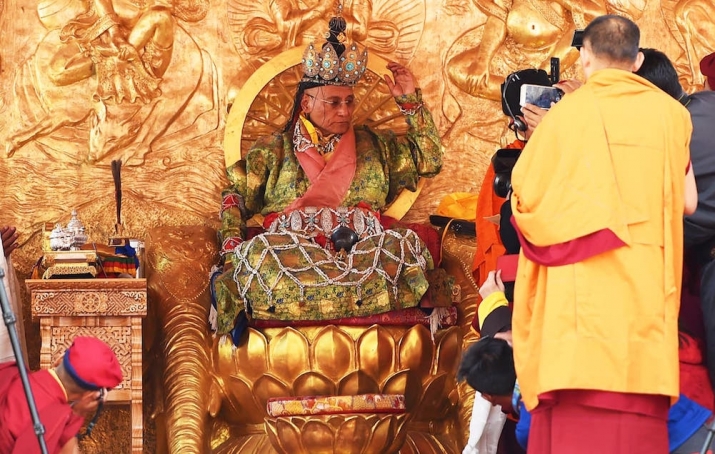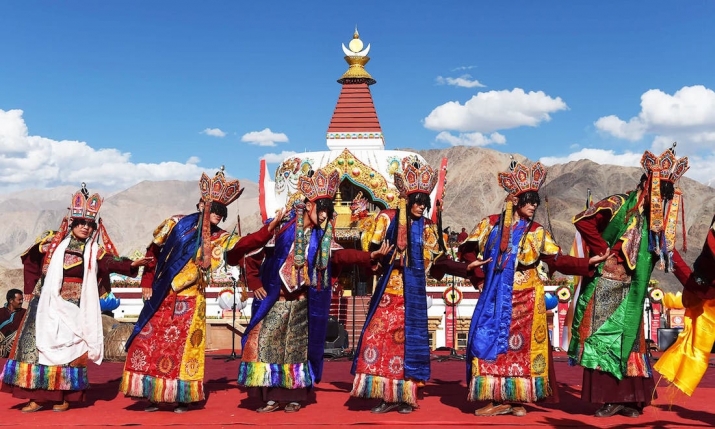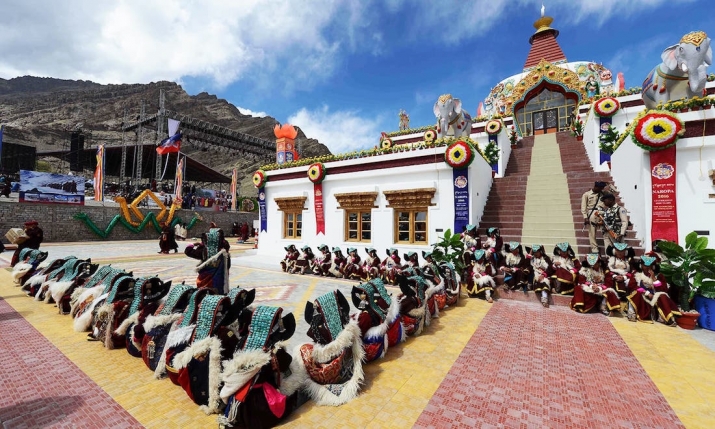NEWS
His Holiness the Gyalwang Drukpa Marks 1,000th Birth Anniversary of Naropa in Ladakh
 His Holiness the Gyalwang Drupa, head of the Drukpa lineage, wearing the six sacred bone ornaments of Naropa. From dawn.com
His Holiness the Gyalwang Drupa, head of the Drukpa lineage, wearing the six sacred bone ornaments of Naropa. From dawn.comTens of thousands of monastics, lay Buddhists, and curious tourists have flocked to the village of Hemis in the remote Ladakh region of northern India to attend a seven-day spiritual gathering, which began on 16 September and concludes on Thursday, celebrating the 1,000th birth anniversary of the Indian Buddhist mahasiddha Naropa.
Held only once every 12 years at the 17th century Hemis Monastery, the largest Buddhist festival in the Himalayan region draws huge numbers of Buddhist devotees, in particular followers of the Drukpa lineage of Vajrayana Buddhism. The scholar Naropa, a contemporary of the Bengali Buddhist master Atisa (980–1054), is renowned for starting a rich tradition of Buddhist philosophy in the 11th century. His teaching of the Six Yogas of Naropa are considered to be one of the fundamental pillars of the Vajrayana Buddhist tradition.
Among the festival’s major events, was the display of the six sacred bone ornaments believed to have belonged to Naropa, in an hours-long outdoor ceremony. The renowned humanitarian, author, environmentalist, and champion of gender equality, His Holiness the Gyalwang Drukpa, spiritual head of the Drukpa lineage, unveiled and donned the ornaments—a crown, earrings, a necklace, a seralkha, a bangle, and an anklet—in front of chanting monks and lay Buddhists at Naro Palace, before granting the Grand Chakrasamvara Empowerment.
 Dancers perform during the Naropa Festival. From dawn.com
Dancers perform during the Naropa Festival. From dawn.com“It’s rare indeed since this opportunity comes only once in 12 years.” said 30-year-old lama Thuksey Rinpoche, chairman of the mammoth event’s organizing committee, explaining that Naropa was offered the six bone ornaments by dakinis when he attained enlightenment. “These ornaments are revered relics of Buddhism and historic symbols of a great Himalayan odyssey. From Naropa, several Buddhist traditions flourished throughout India, Central Asia, and beyond. For close to 1,000 years, the six bone ornaments have been used as a relic of devotional support.” (India Today)
“This week-long festivity stands strong and firm on the two main concrete pillars of His Holiness’ message, vision and goal of eco-friendly way of living, gender equality and woman empowerment,” Rinpoche added. (The Hindu)
Another major highlight was the ceremonial unfurling of a huge silk thangkha of Padmasambhava by the Gyalwang Drukpa, which was last displayed 12 years ago at the previous festival. In addition, more than 200 “kung fu” nuns belonging to various Drukpa nunneries across the Himalayan region gave drum and cultural performances during the festival. The nuns arrived in Ladakh just four days before the festival, having traversed 2,500 kilometers from Kathmandu on a bicycle pilgrimage led by the Gyalwang Drukpa.
“I come from South India. Now I came here to see this festival . . . there are many people [who] came by airplane and from South India and other countries,” Sonam Phuntsok, a Buddhist monk from the Indian city of Bangalore. “[It’s a] very nice place here. And the weather is very good. Lots of people came here, I'm very happy.” (Dawn)
 Performers wait to dance in front of Naro Palace. From dawn.com
Performers wait to dance in front of Naro Palace. From dawn.comAfter the conclusion of the celebration, the Gyalwang Drukpa will lead monastics and lay Buddhists on a 10-day eco pad yatra walking pilgrimage into Ladakh to create awareness about sustainable environmentalism.
Founded in Tibet by Tsangpa Gyare Yeshi Dorje (1161–1211), the first Gyalwang Drukpa, the Drukpa lineage is a branch of the Kagyu school of Tibetan Buddhism. Along with the Sakya and Gelug, the Kagyu tradition is classified as one of the Sarma or “New Transmission” schools. The Drukpa lineage is also the dominant school of Buddhism and the state religion in Bhutan.
See more
Thousands flock to Indian Himalayas for rare Buddhist festival (Dawn)
Kumbh Mela of the Himalayas begins in Leh (The Hindu)
60-foot-tall silk brocade displayed at Naropa festival (Business Standard)
Once in 12 years: Leh gears up for the 'Kumbh of Himalayas' (India Today)
Naropa 2016 (Facebook)
Gyalwang Drukpa
Related
“Kung Fu Nuns” Arrive At India’s “Golden Temple” (Buddhistdoor Global)
Gyalwang Drukpa Leads Cyclists on 4th Drukpa Eco Cycle Yatra (Buddhistdoor Global)
Gyalwang Drukpa Leads “Kung Fu Nuns” on Bicycle Pilgrimage to New Delhi (Buddhistdoor Global)
The Druk Amitabha Kung Fu Nuns: Combining Martial Arts and Meditation (Buddhistdoor Global)
The “Eco Pad Yatra”: A Transformative Journey (Buddhistdoor Global)














